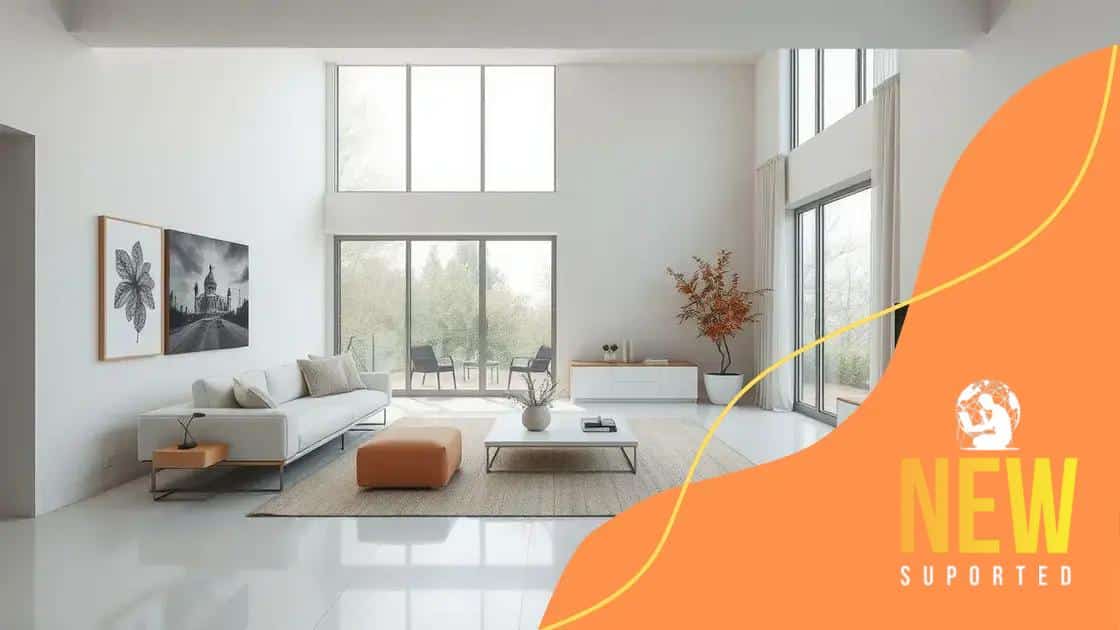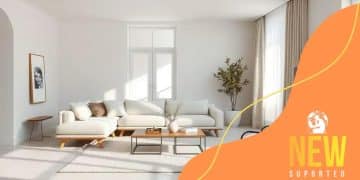How to create a minimalist home design in 2025

To create a minimalist home design in 2025, focus on simplicity by utilizing a neutral color palette, multifunctional furniture, and incorporating natural elements to maximize space and enhance overall tranquility.
How to create a minimalist home design in 2025 can seem daunting, but it’s all about simplicity and functionality. Imagine your space filled with only what you truly need and love. Ready to transform your home?
Understanding minimalist design principles
Understanding minimalism in design is about appreciating simplicity. The goal is to create spaces that are functional yet aesthetically pleasing. A minimalist design emphasizes clean lines, open spaces, and a limited color palette.
Core Principles of Minimalism
At the heart of minimalist design are a few core principles. These principles guide the choices you make in creating your space:
- Prioritize functionality over decoration.
- Opt for a neutral color palette with occasional bold accents.
- Limit the number of items to reduce clutter.
- Focus on quality over quantity when selecting furniture.
Embracing these elements will help you appreciate the beauty in simplicity. Fewer items mean clearer spaces, allowing your room to breathe. Opting for multifunctional furniture can also contribute to a more open and airy environment.
Choosing the Right Materials
In a minimalist home, materials play a vital role. You want to choose quality materials that are both beautiful and durable.
Natural materials like wood, stone, and metal often work best. For example, light-colored woods can create warmth while maintaining a modern feel. Pairing these materials with soft textiles adds comfort without overwhelming the senses.
Remember, the goal of minimalism is to promote peace and functionality. Achieving this balance can transform your living space into a serene retreat.
Choosing a color palette for minimalism
Choosing a color palette for minimalism is essential to create a peaceful and inviting space. A well-thought-out color scheme can enhance the beauty of minimalist design and make areas feel more open.
Understanding Minimalist Colors
The colors you choose should promote calmness and simplicity. Neutrals often work best in a minimalist home. Shades like white, beige, and gray provide a clean backdrop. These colors act as a canvas for your decor.
- Use white for a fresh and airy atmosphere.
- Beige adds warmth without overwhelming.
- Soft gray can create a sophisticated, modern feel.
Occasionally, you can introduce bold colors. However, it’s important to limit them. A single accent wall or a few decorative pieces can add interest without disturbing the overall tranquility. Think of calming blues, gentle greens, or even muted earthy tones.
Creating Harmony with Colors
Harmony in your color palette is crucial. When selecting colors, consider how they flow together. A cohesive palette will unify your space and enhance the minimalist look. Choose two or three main colors and stick to variations of these throughout.
For instance, combining soft whites with light wood tones can create a warm and inviting environment. Aim for balance; cool colors can be paired with warmer tones to ensure the space feels comfortable and welcoming.
Ultimately, the right color palette can transform a simple space into a serene retreat. By focusing on a limited range, you can achieve a clean and sophisticated look that epitomizes minimalism.
Selecting furniture for a minimalist home

Selecting furniture for a minimalist home involves choosing pieces that enhance simplicity and functionality. It’s important to focus on quality and design over quantity. Every item should serve a purpose, allowing the space to feel open and uncluttered.
Key Features of Minimalist Furniture
When picking furniture, look for key features that align with the minimalist design philosophy. This includes:
- Clean lines and shapes that are easy on the eyes.
- Neutral colors that blend well with other elements.
- Functional pieces that offer storage solutions.
- Durable materials that withstand the test of time.
Choosing furniture that incorporates these features will elevate your living space. For instance, a simple coffee table without ornate designs allows the room to breathe while still being functional.
Multi-Functional Furniture
Another essential aspect is selecting multi-functional furniture. This helps minimize clutter and maximize space usability. For example, consider a sofa bed or an ottoman that doubles as storage. These types of furniture allow you to keep your space organized without sacrificing style.
Moreover, when you can, opt for modular furniture that can adapt to different needs. Pieces that can be rearranged easily will enhance your home’s versatility, allowing for a dynamic living area.
Beyond functionality, ensure the styles you select speak to your personal taste while upholding the minimalist aesthetic. Remember, less is more. Each piece should add value and harmony to your home without overcrowding it.
Incorporating natural elements into design
Incorporating natural elements into design brings warmth and life to a minimalist home. Nature can enhance the beauty of your space while promoting a sense of calm. Simple touches can make a huge difference in your home’s atmosphere.
Using Plants for a Fresh Touch
Plants are one of the easiest ways to connect your home to nature. They purify the air and add a splash of color. When choosing plants, opt for varieties that require minimal maintenance. Here are a few great options:
- Succulents: These vibrant plants thrive on little water.
- Snake plants: Nearly indestructible, they require low light and care.
- Pothos: A trailing plant known for its adaptability.
Placing plants in simple pots can complement your minimalist style. Consider using natural materials, like terracotta or ceramic, for a cohesive look.
Natural Materials in Furniture
In addition to plants, incorporating natural materials into your furniture can enhance the organic feel of your space. Wood, stone, and linen bring texture and warmth. Look for furniture made from reclaimed wood or sustainably sourced materials. These choices align with the minimalist philosophy and showcase craftsmanship.
Natural elements can also be included through textiles. Use cotton or wool for soft furnishings like cushions and throws. Neutral tones will keep the atmosphere light and airy.
Finally, consider bringing in aspects of the outdoors through large windows or open spaces. Maximizing natural light creates an inviting, uplifting environment.
Maximizing space in a minimalist layout
Maximizing space in a minimalist layout is essential for creating a comfortable and functional environment. With thoughtful planning, you can ensure every inch serves a purpose, making your home feel open and inviting.
Smart Storage Solutions
One effective way to maximize space is through smart storage solutions. Utilize vertical space by adding shelves or cabinets up to the ceiling. This approach not only uses space efficiently but also keeps the floor clear.
- Consider multi-functional furniture like ottomans with hidden storage.
- Install wall-mounted shelves instead of bulky bookcases.
- Use under-bed storage for items you don’t need daily.
These solutions help minimize clutter while maintaining a clean aesthetic. A tidy environment contributes to the overall appeal of a minimalist home.
Open Floor Plans
Another aspect of maximizing space is the use of open floor plans. By removing unnecessary walls, you create a sense of flow that enhances the feeling of spaciousness. Open layouts allow for better natural light to circulate.
Furniture can be arranged to define areas without closing off spaces. For example, a strategically placed sofa can separate the living area from the dining space while leaving sight lines clear.
Don’t forget about area rugs. They can help define different zones while still keeping the space open and cohesive. This flow is a staple of minimalist design, ensuring comfort without overcrowding.
Colors play a role too. Lighter shades can make spaces feel larger, while darker colors can enclose them. Overall, maximizing space in a minimalist layout combines smart design with thoughtful choices for functionality and style.
FAQ – Frequently Asked Questions about Minimalist Home Design
What are the main principles of minimalist design?
The main principles of minimalist design include simplicity, functionality, and the use of a limited color palette to create a clean and open space.
How can I maximize space in a small home?
To maximize space, use multi-functional furniture, smart storage solutions, and maintain an open floor plan that allows for easy movement.
What types of plants work best in a minimalist home?
Succulents, snake plants, and pothos are great choices for a minimalist home as they require low maintenance and add a touch of greenery.
How can I choose the right color palette for a minimalist design?
Opt for neutral colors like whites, grays, and beiges, and consider adding a few bold accents to create interest without overwhelming the space.






